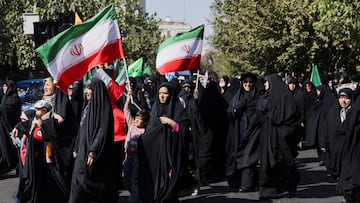Iran considers building a new capital: “We have no choice, it’s unsustainable”
Tehran faces serious problems such as drought, pollution, and subsidence, all while its population grows.

Iran’s President Masoud Pezeskhian has once again emphasized the urgent need to build a new capital on the country’s southern coast. He warned that life in Tehran “will become unsustainable” and “unviable” due to a confluence of crises: pollution, water shortages, subsidence, and chaotic traffic. “There is no longer any choice; we are forced to. Life in Tehran will become unsustainable,” he asserted.
Tehran has served as Iran’s political, administrative, and economic center since it was designated the capital in 1786 by King Mohammad Khan of the Qajar Agha dynasty. Located in the north near the Caspian Sea, the city’s population continues to swell. The last census, conducted in 2015, counted 12 million residents, but the current figure is estimated to be as high as 18 million and is projected to reach around 20 million in the next 30 years.
⚠️ 𝐁𝐫𝐞𝐚𝐤𝐢𝐧𝐠 𝐍𝐞𝐰𝐬 ⚠️
— Iran Spectator (@IranSpec) January 9, 2025
🇮🇷 | Iran says capital will be moved to Makran on southern coast…
Iranian officials are seriously planning on moving the capital from Tehran to Makran.
The plan aims to address Tehran’s overpopulation crisis, however the exact location of the… pic.twitter.com/7KOXzbMMgt
Several critical factors fuel the debate over relocation. According to data from Iran’s Ministry of Health, reported by Anadolu Agency, air pollution has killed 20,800 people nationwide. Of those, 6,400 died in Tehran, a city simultaneously suffering from subsidence—the sinking of the ground caused by the overexploitation of aquifers. The Iranian Building and Housing Research Center indicates that Tehran is sinking, on average, by 25 centimeters per year.
Furthermore, Tehran is situated in a high-risk earthquake area. This hazard is gravely amplified by the fact that 60% of the city’s buildings do not meet seismic safety standards, according to a 2021 statement issued by city authorities. Adding to these existential threats is a severe water shortage: experts cited by Anadolu Agency report that the city’s reservoirs are nearly empty, even though Tehran consumes 25% of the country’s total drinking water.
Faced with these insurmountable challenges, Pezeskhian had previously stated: “Whatever we do, we’re just wasting time. We have no choice but to move the country’s economic and political center to the south, closer to the sea.”
His main option is to locate the new capital on the Persian Gulf coast, which Iran shares with Kuwait, Saudi Arabia, Bahrain, Qatar, and the United Arab Emirates. The justification for this location is compelling: the Gulf holds the country’s largest oil and natural gas reserves, features a lower seismic risk, and offers a more suitable climate. Government spokesperson Fatemeh Mohajerani confirmed that the Makran region, a semi-desert area on the Gulf of Oman, is an option under “serious” consideration.
Today is #Tehran Day, the Capital of #Iran, a city that symbolizes beauty, kindness, warm-hearted, hardworking & hospitable people. ❤️🫶 pic.twitter.com/ZIqvT4QKdM
— Iran Embassy in the Philippines (@IRANinPH) October 6, 2025
Related stories
Despite the environmental and economic logic, the plan is hindered by the estimated $80 billion cost, which Iran is not yet prepared to assume. Moreover, fundamental doubts about the efficacy of the move persist: Would relocating the capital truly solve all the nation’s problems?
Get your game on! Whether you’re into NFL touchdowns, NBA buzzer-beaters, world-class soccer goals, or MLB home runs, our app has it all. Dive into live coverage, expert insights, breaking news, exclusive videos, and more – plus, stay updated on the latest in current affairs and entertainment. Download now for all-access coverage, right at your fingertips – anytime, anywhere.


Complete your personal details to comment